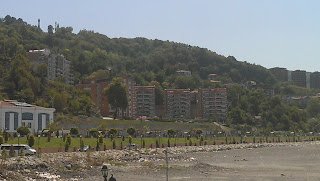Two days of surveying the different neighborhoods of Zonguldak was fascinating. We all experienced the difficult topography of the city, heard about interesting stories of people living in the city, tried to make the link between changes in employment and economic structure of the city and social and spatial changes. Observations of the different aspects of socio-economic, cultural and spatial development in the city of Zonguldak on site obviously challenged the 'stereotype' we had before the fieldwork, and brought a lot of questions.
On our fifth day in the field, we were hosted by the Municipality of Zonguldak to the representatives of whom we could ask various issues that we observed when surveying the neighborhoods and learn about their strategies and policies for the urban development in Zonguldak.
Property Development Issues in Zonguldak
A very interesting information that was given by the Municipality was related with property development in Zonguldak, which was determined by a special law-Havza-i Fahmiye (1920). The mining basin of the city was registered to the Treasuary and did not allowed the deleopment of private property until 1986. This law has had a significant impact on the spatial development of the city. We were informed that as of today only 20% of the land in the city of Zonguldak is private property, which the remaining 80% is owned either by TTK, or the national estate or is forest. Eventually, 80% of Zonguldak developed illegally, an issue which seems to be a major concern for the Municipality of Zonguldak.
Illegal development in Zonguldak, Kilimli
Spatial impacts of urban shrinkage
One of the observations of our team when doing the landuse and questionnaire surveys was the difficulty of observing abandoned buildings in the city, which lost 50 000 population since 1990. In fact, many people mentioned the need for more housing in Zonguldak, and we observed new housing developments in the different parts of the city. We were informed that the Municipality allowed high rise housing developments on privately owned land,with the aim to decrease squatter housing. While this is the case, we were also informed that there were 8000 abandoned, empty units in the city.
New housing development in the city of Zonguldak, Kozlu
New housing development in the city ofZonguldak, Kilimli
Managing/unmanaging shrinkage?
As with many shrinking cities around the world, the phenomenon of shrinkage is not on the agenda of the Municipality. While acknowledging the impact of the restructuring of the mining industry-and mainly TTK- on the city and outmigration, they have never mentioned population figures nor they seemed to acknowledge the loss of population. The approach of the Municipality was that outmigration would be reversed if they would develop registered land as a result of which the ones who had left would come and invest in the city. Further higher rise development of private property and transformation of TTK's housing estates through urban transformmation projects are the instruments used by the Municipality for this purpose. We were stroke when we weretold that the new zoning plan was for a city that will accomodate 350 000 people fifty years later.
Environmental Issues
A major issue in the city of Zonguldak is related with the environmental impacts of mining. The city has been created on top of the mine excavation zones which damage the buildings. What stroke us was that the new housing developments started to take place on these physically unconvenient land.
Having informed about and being struck by the approach of the Municipality of Zonguldak for the future of the city, research teams continued with further visits to other institutions to continue with data collection related with their research topics.



No comments:
Post a Comment